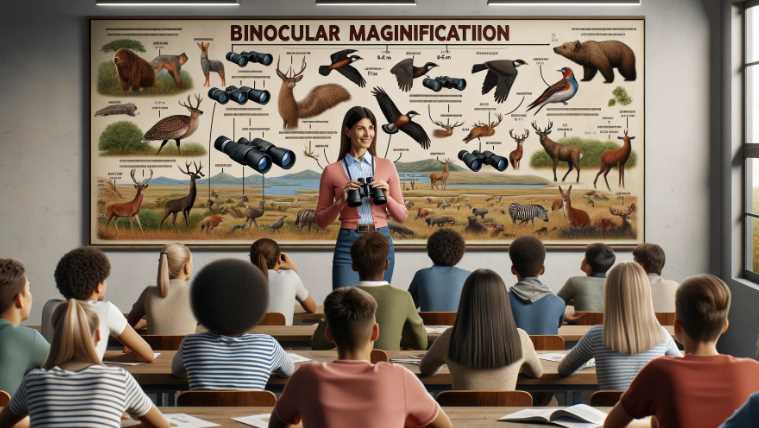For hunting, a magnification of 8x or 10x is considered best. The second number, the objective lens diameter, is good between 32mm and 50mm. This ensures a balance of portability, brightness, and detailed observation, especially in low-light conditions like dawn or dusk. The preferred choices are 8×32, 8×42, 10×42, or 10×50 for effective hunting binoculars.

Recommended Binocular Specifications for Hunting: Finding Your Perfect Pair
When it comes to binoculars for hunting, the choices seem as vast as the landscapes you aim to explore. To navigate this terrain effectively, it’s crucial to delve into the specifics of popular options: the 8×32, 8×42, 10×42, and 10×50. Each comes with its own set of advantages and disadvantages, making it essential to align your choice with your unique hunting style.
1. 8×32: The Sweeping Panorama
Advantages:
- Wider Field of View: The 8x magnification offers a broader perspective, making it ideal for scanning vast terrains.
- Lightweight and Portable: Weighing less than their larger counterparts, the 8×32 binoculars won’t weigh you down during extended treks.
Disadvantages:
- Limited Detail at a Distance: The lower magnification sacrifices some details when observing distant targets.

2. 8×42: A Balanced All-Rounder
Advantages:
- Versatile Magnification: Strikes a balance between a wide field of view and ample magnification, making it suitable for various hunting scenarios.
- Good Low-Light Performance: The 42mm objective lens diameter enhances brightness, crucial during dawn or dusk.
Disadvantages:
- Slightly Heavier: Compared to the 8×32, the 8×42 is a bit heavier, which might be a consideration during long hunts.
3. 10×42: Precision in Every Detail
Advantages:
- Detailed Observation: The 10x magnification brings distant targets into sharp relief, perfect for observing intricate details.
- Balanced Objective Lens: The 42mm diameter maintains a good balance between brightness and portability.
Disadvantages:
- Reduced Field of View: The higher magnification narrows the field of view, making it less suitable for scanning large areas quickly.
4. 10×50: Zooming in on Distant Targets
Advantages:
- Exceptional Magnification: The 10x magnification combined with the 50mm objective lens provides unparalleled clarity for long-range observation.
- Superior Low-Light Performance: The larger objective lens captures more light, enhancing visibility in low-light conditions.
Disadvantages:
- Heavier and Bulkier: The larger objective lens contributes to increased weight, impacting the binoculars’ overall portability.
How Different Specifications Cater to Specific Hunting Scenarios
Choosing between these specifications is not a one-size-fits-all endeavor. Your preferred hunting scenarios dictate which pair aligns best with your needs. The 8×32 or 8×42 might be the go-to choices for open terrains that demand extensive scanning. If precision in observing distant targets is your priority, the 10×42 or 10×50 could be your trusted companions.

Considerations for Personal Preferences and Hunting Styles
Beyond the technical specifications, personal preferences and individual hunting styles play a crucial role in the decision-making process. Some hunters prefer the nimbleness of lighter binoculars for quick maneuvers, while others prioritize the enhanced visibility provided by larger lenses. Understanding your preferences ensures that your chosen binoculars become an extension of your hunting instincts, enhancing rather than hindering your overall experience.
5 Factors Influencing Binocular Effectiveness in Hunting: Navigating the Wilderness of Choices

Hunting is a symphony of senses, and binoculars act as the orchestrators, harmonizing vision with the vast landscapes. Understanding the factors influencing binocular effectiveness is paramount in ensuring your gear enhances rather than hinders your hunting experience.
Magnification and Field of View: Striking the Right Balance
In the world of binoculars, magnification is a double-edged sword. While higher magnification allows you to zoom in on distant targets, it also amplifies hand shake and reduces the field of view. Striking the right balance, especially in dynamic hunting scenarios, is crucial. Too much magnification may result in missing the bigger picture, while too little may sacrifice the clarity needed for precise identification.
Objective Lens Diameter: Shedding Light on Low-Light Conditions
The objective lens diameter plays a pivotal role in determining how much light your binoculars can gather. In the dim light of dawn or dusk, a larger objective lens diameter becomes your ally, ensuring brighter and clearer images. However, it’s a delicate dance, as a larger lens also contributes to increased weight and bulk, impacting portability.
Comparing Magnification and Objective Lens Diameter
| Binoculars | Magnification | Objective Lens Diameter | Field of View |
|---|---|---|---|
| 8×32 | 8x | 32mm | Wider |
| 8×42 | 8x | 42mm | Balanced |
| 10×42 | 10x | 42mm | Reduced |
| 10×50 | 10x | 50mm | Narrow |
Balancing Portability and Performance: The Weight Dilemma

Hunters are akin to nomads, traversing varied terrains. The weight of your binoculars becomes a critical factor, impacting not only comfort during long treks but also the ease of maneuverability. It’s a delicate trade-off between the desire for larger objective lenses and the practicality of carrying them through diverse landscapes.
Environmental Conditions: The Unpredictable Variable
Nature is unpredictable, and so are the environments where hunting unfolds. Rain, fog, or extreme temperatures can impact the effectiveness of your binoculars. Choosing a pair with features like water resistance and fog-proofing ensures your gear stands resilient in the face of nature’s whims.
Tailoring Choices to Individual Needs: Personal Preferences and Styles
While specifications and tables offer a structured guide, personal preferences and hunting styles inject the element of individuality. Some hunters prioritize a wider field of view for scanning vast terrains, while others crave the precision of higher magnification for detailed observations. Understanding your own preferences ensures your binoculars become an extension of your instincts, seamlessly integrating into your hunting rhythm.
6 Tips for Choosing the Right Binoculars for Hunting: A Hunter’s Guide
Hunting is a pursuit where every choice, every gear, can distinguish between success and a missed opportunity. When it comes to choosing the right binoculars, it’s more than just picking a pair off the shelf. Here are some tips derived from personal experience that can guide you in making an informed decision.
Budget Considerations: Balancing Features and Cost
Before delving into the world of specifications, set a realistic budget. While the market offers binoculars at various price points, balancing features with cost is crucial. Remember that quality optics often come with a price, but finding that sweet spot where performance meets budget is key.
Try Before You Buy: The Hands-On Approach
Binoculars are an extension of your eyes in the field. It’s imperative to get hands-on experience before making a purchase. Visit a store where you can test different models. Assess how they feel in your hands, how easy they are to adjust, and how well they perform in terms of clarity and focus. The nuances that matter become apparent only through the hands-on approach.
Weight and Size: The Practical Considerations
Hunting often involves traversing challenging terrains. Consider the weight and size of the binoculars, especially if you plan on carrying them for extended periods. A pair that is too heavy might become a burden during long treks, affecting your overall comfort and maneuverability.
Durability: Built to Withstand the Wilderness
Nature can be unforgiving, and your gear needs to withstand the elements. Look for binoculars that are rugged, waterproof, and fog-proof. Durability is not just a feature; it’s an assurance that your binoculars will perform reliably in various weather conditions.
Consider Your Specific Hunting Needs: Tailoring to Your Style
Hunting styles vary, and so do the requirements for binoculars. If you prefer stalking through dense woods, a wider field of view might be crucial. For those who focus on long-range observation, higher magnification becomes a priority. Tailor your choice to match your specific hunting style, ensuring your binoculars seamlessly integrate into your approach.
Check for Eye Relief: Comfort for Prolonged Use
Long hours of hunting demand comfort. Ensure that the binoculars you choose have adequate eye relief, preventing eye strain during extended use. This is especially important for those who wear glasses, as it allows for comfortable viewing without compromising on clarity.
Advantages of 8x and 10x Magnifications in Hunting: A Closer Look
When choosing binoculars for hunting, the decision often boils down to two main magnifications: 8x and 10x. The advantages of each magnification cater to distinct aspects of the hunting experience. The 8x provides a sweeping panorama, perfect for scanning terrains, tracking movements, and ensuring a wide field of view.
On the other hand, the 10x magnification excels in precision, bringing distant targets into sharp relief, unveiling intricate details crucial for successful hunting. Your choice between 8x and 10x hinges on the dynamics of your hunting grounds and the specifics of your preferred approach, with each magnification offering a unique lens into the wild.
Comparing Objective Lens Diameters: Shedding Light on Your Vision
The objective lens diameter, whether 32mm, 42mm, or 50mm, plays a pivotal role in determining the brightness and clarity of your binoculars. A larger objective lens captures more light, enhancing visibility in low-light conditions, making the 10×50, for example, excel in the early dawn or late dusk.
However, this advantage comes with a trade-off—increased weight and bulk. The 8×42 strikes a balance, offering good brightness without compromising too much on portability. Choosing the right objective lens diameter involves finding equilibrium between luminosity and practicality, tailoring your choice to the specific demands of your hunting escapades.
Final Words
In the vast hunting tapestry, the magnification and objective lens diameter of your binoculars are the threads that weave clarity and detail into your every observation. Whether you opt for the broader perspective of 8x or the precision of 10x and navigate the trade-offs of objective lens diameters, the goal remains to enhance your connection with the wild.
As you embark on your hunting journeys, may your chosen binoculars become not just tools, but trusted companions, revealing the intricacies of the wilderness with every glance. Happy hunting!
Resources and References:
- Expert Reviews and Comparisons:
- OutdoorGearLab – Unbiased reviews and detailed comparisons of various binocular models.
- Bird Watcher’s Digest – A resource not only for birdwatchers but also offering insights into optics suitable for hunters.
- Manufacturer Specifications:
- Nikon Hunting Optics – Nikon’s official website provides detailed specifications for their hunting optics lineup.
- Vortex Optics – A trusted manufacturer offering a wide range of hunting binoculars with detailed specifications.
- Community Feedback and Discussions:
- HuntingNet Forums – Engage with fellow hunters to gather real-world experiences and recommendations.
- Reddit – r/hunting – A community-driven platform where hunters share their insights and advice on gear, including binoculars.
- Field Tests and Experiences:
- Field & Stream – Features articles and field tests on hunting gear, providing practical insights.
- American Hunter – Explore gear reviews and articles tailored to the needs of hunters.
- Optics Studies and Guides:
- OpticsPlanet Blog – Offers informative articles covering various aspects of optics, including binoculars.
- All About Vision – A comprehensive resource for understanding optics and vision-related topics.
- Binocular Buying Guides:
- Cabela’s – Known for outdoor gear, Cabela’s provides buying guides and customer reviews for binoculars.
- Bass Pro Shops – A source for outdoor enthusiasts, offering buying guides and reviews on hunting optics.

I am an enthusiastic student of optics, so I may be biased when I say that optics is one of the most critical fields. It doesn’t matter what type of optics you are talking about – optics for astronomy, medicine, engineering, or pleasure – all types are essential.
Last update on 2025-10-06 / Affiliate links / Images from Amazon Product Advertising API
Table of Contents




Pingback: Navigating the Binocular Maze: Choosing the Perfect Magnification
Pingback: What binocular magnification is best for astronomy?